标签:custom root 实现 throw 对象 疑问 拦截器 collect 索引
开启异步调用只需一个注解@EnableAsync
@Target(ElementType.TYPE) @Retention(RetentionPolicy.RUNTIME) @Documented @Import(AsyncConfigurationSelector.class) public @interface EnableAsync { /** * Indicate the ‘async‘ annotation type to be detected at either class * or method level. * <p>By default, both Spring‘s @{@link Async} annotation and the EJB 3.1 * {@code @javax.ejb.Asynchronous} annotation will be detected. * <p>This attribute exists so that developers can provide their own * custom annotation type to indicate that a method (or all methods of * a given class) should be invoked asynchronously. */ Class<? extends Annotation> annotation() default Annotation.class; /** * Indicate whether subclass-based (CGLIB) proxies are to be created as opposed * to standard Java interface-based proxies. * <p><strong>Applicable only if the {@link #mode} is set to {@link AdviceMode#PROXY}</strong>. * <p>The default is {@code false}. * <p>Note that setting this attribute to {@code true} will affect <em>all</em> * Spring-managed beans requiring proxying, not just those marked with {@code @Async}. * For example, other beans marked with Spring‘s {@code @Transactional} annotation * will be upgraded to subclass proxying at the same time. This approach has no * negative impact in practice unless one is explicitly expecting one type of proxy * vs. another — for example, in tests. */ boolean proxyTargetClass() default false; /** * Indicate how async advice should be applied. * <p><b>The default is {@link AdviceMode#PROXY}.</b> * Please note that proxy mode allows for interception of calls through the proxy * only. Local calls within the same class cannot get intercepted that way; an * {@link Async} annotation on such a method within a local call will be ignored * since Spring‘s interceptor does not even kick in for such a runtime scenario. * For a more advanced mode of interception, consider switching this to * {@link AdviceMode#ASPECTJ}. */ AdviceMode mode() default AdviceMode.PROXY; /** * Indicate the order in which the {@link AsyncAnnotationBeanPostProcessor} * should be applied. * <p>The default is {@link Ordered#LOWEST_PRECEDENCE} in order to run * after all other post-processors, so that it can add an advisor to * existing proxies rather than double-proxy. */ int order() default Ordered.LOWEST_PRECEDENCE; }
AsyncConfigurationSelector的作用是从两个异步配置类中选择一个来完成底层异步代理的工作。这个两个配置类分别是AspectJAsyncConfiguration、ProxyAsyncConfiguration。
@Override @Nullable public String[] selectImports(AdviceMode adviceMode) { switch (adviceMode) { case PROXY: return new String[] {ProxyAsyncConfiguration.class.getName()}; case ASPECTJ: return new String[] {ASYNC_EXECUTION_ASPECT_CONFIGURATION_CLASS_NAME}; default: return null; } }
其中adviceMode就是@EnableAsync注解中mode()方法的值,默认是"PROXY"。接下来着重看一下ProxyAsyncConfiguration做了哪些事情。
@Configuration @Role(BeanDefinition.ROLE_INFRASTRUCTURE) public class ProxyAsyncConfiguration extends AbstractAsyncConfiguration { @Bean(name = TaskManagementConfigUtils.ASYNC_ANNOTATION_PROCESSOR_BEAN_NAME) @Role(BeanDefinition.ROLE_INFRASTRUCTURE) public AsyncAnnotationBeanPostProcessor asyncAdvisor() { Assert.notNull(this.enableAsync, "@EnableAsync annotation metadata was not injected"); AsyncAnnotationBeanPostProcessor bpp = new AsyncAnnotationBeanPostProcessor(); bpp.configure(this.executor, this.exceptionHandler); Class<? extends Annotation> customAsyncAnnotation = this.enableAsync.getClass("annotation"); if (customAsyncAnnotation != AnnotationUtils.getDefaultValue(EnableAsync.class, "annotation")) { bpp.setAsyncAnnotationType(customAsyncAnnotation); } bpp.setProxyTargetClass(this.enableAsync.getBoolean("proxyTargetClass")); bpp.setOrder(this.enableAsync.<Integer>getNumber("order")); return bpp; } }
ProxyAsyncConfiguration主要是创建了一个基于异步调用的后置处理器(AsyncAnnotationBeanPostProcessor),改BPP中设置了executor(异步线程池)、exceptionHandler(异常处理器)、AsyncAnnotationType(异步注解类型)、proxyTargetClass(代理创建模式)、order(后置处理器执行顺序)。那么executor和exceptionHandler是哪里来的呢、默认值是什么?接着继续向父集探索。
@Configuration public abstract class AbstractAsyncConfiguration implements ImportAware { ..... /** * Collect any {@link AsyncConfigurer} beans through autowiring. */ @Autowired(required = false) void setConfigurers(Collection<AsyncConfigurer> configurers) { if (CollectionUtils.isEmpty(configurers)) { return; } if (configurers.size() > 1) { throw new IllegalStateException("Only one AsyncConfigurer may exist"); } AsyncConfigurer configurer = configurers.iterator().next(); this.executor = configurer::getAsyncExecutor; this.exceptionHandler = configurer::getAsyncUncaughtExceptionHandler; } }
由此可见,executor和exceptionHandler可以通过AsyncConfigurer自定义配置。需要注意的是,spring容器中只能有一个AsyncConfigurer类型的实例呦。
进入异步实现的正题了,当然是好好研究一下AsyncAnnotationBeanPostProcessor这个后置处理做了哪些事情了。
public class AsyncAnnotationBeanPostProcessor extends AbstractBeanFactoryAwareAdvisingPostProcessor { .... @Override public void setBeanFactory(BeanFactory beanFactory) { super.setBeanFactory(beanFactory); AsyncAnnotationAdvisor advisor = new AsyncAnnotationAdvisor(this.executor, this.exceptionHandler); if (this.asyncAnnotationType != null) { advisor.setAsyncAnnotationType(this.asyncAnnotationType); } advisor.setBeanFactory(beanFactory); this.advisor = advisor; } }
1、添加一个AOP advisor(AsyncAnnotationAdvisor),识别带有@Async注解或者指定类型注解的方法,创建代理类。
2、找一个合适的TaskExecutor来异步调用带有@Async注解或者指定类型注解的方法。
3、如果方法在异步调用过程中抛出异常,将使用合适的ExceptionHandler进行处理。
看到这里,已经有两个疑问了。AsyncAnnotationAdvisor做了什么?如何创建的异步调用代理类?
大家都知道,Spring Aop中,一个advisor包含一个advice(通知)、pointcut(切点)。
创建advice
protected Advice buildAdvice( @Nullable Supplier<Executor> executor, @Nullable Supplier<AsyncUncaughtExceptionHandler> exceptionHandler) { AnnotationAsyncExecutionInterceptor interceptor = new AnnotationAsyncExecutionInterceptor(null); interceptor.configure(executor, exceptionHandler); return interceptor; }
AnnotationAsyncExecutionInterceptor是一个方法拦截器,父级接口是我们最熟悉的org.aopalliance.intercept.MethodInterceptor。这个拦截器有个优秀的功能,可以根据不同的方法选择不同的taskexecutor来异步执行,即Async#value()方法的值。
public Object invoke(final MethodInvocation invocation) throws Throwable { Class<?> targetClass = (invocation.getThis() != null ? AopUtils.getTargetClass(invocation.getThis()) : null); Method specificMethod = ClassUtils.getMostSpecificMethod(invocation.getMethod(), targetClass); final Method userDeclaredMethod = BridgeMethodResolver.findBridgedMethod(specificMethod); AsyncTaskExecutor executor = determineAsyncExecutor(userDeclaredMethod); if (executor == null) { throw new IllegalStateException( "No executor specified and no default executor set on AsyncExecutionInterceptor either"); } Callable<Object> task = () -> { try { Object result = invocation.proceed(); if (result instanceof Future) { return ((Future<?>) result).get(); } } catch (ExecutionException ex) { handleError(ex.getCause(), userDeclaredMethod, invocation.getArguments()); } catch (Throwable ex) { handleError(ex, userDeclaredMethod, invocation.getArguments()); } return null; }; return doSubmit(task, executor, invocation.getMethod().getReturnType()); }
拦截器的invoke方法看一下瞬间豁然开朗,寻找方法对应的桥接方法、选择一个合适的异步执行的executor、创建Callback实例(异常的处理)、提交异步调用任务到executor中。
创建pointcut
public interface Pointcut { /** * Return the ClassFilter for this pointcut. * @return the ClassFilter (never {@code null}) */ ClassFilter getClassFilter(); /** * Return the MethodMatcher for this pointcut. * @return the MethodMatcher (never {@code null}) */ MethodMatcher getMethodMatcher(); /** * Canonical Pointcut instance that always matches. */ Pointcut TRUE = TruePointcut.INSTANCE; } public interface Pointcut { /** * Return the ClassFilter for this pointcut. * @return the ClassFilter (never {@code null}) */ ClassFilter getClassFilter(); /** * Return the MethodMatcher for this pointcut. * @return the MethodMatcher (never {@code null}) */ MethodMatcher getMethodMatcher(); /** * Canonical Pointcut instance that always matches. */ Pointcut TRUE = TruePointcut.INSTANCE; }
一个切点主要包含两个对象ClassFilter(class过滤器)、MethodMatcher(方法匹配器)。AnnotationMatchingPointcut主要匹配注有@Async或者指定类型注解的class或者方法。
继续回到AsyncAnnotationBeanPostProcessor这个后置处理器,父类AbstractBeanFactoryAwareAdvisingPostProcessor是和AbstractAutoProxyCreator(Spring Aop中最常见的创建Aop Proxy的BPP)同一级别的,主要是曝光代理对象的class、强制设置target-class mode。
@Override protected ProxyFactory prepareProxyFactory(Object bean, String beanName) { if (this.beanFactory != null) { AutoProxyUtils.exposeTargetClass(this.beanFactory, beanName, bean.getClass()); } ProxyFactory proxyFactory = super.prepareProxyFactory(bean, beanName); if (!proxyFactory.isProxyTargetClass() && this.beanFactory != null && AutoProxyUtils.shouldProxyTargetClass(this.beanFactory, beanName)) { proxyFactory.setProxyTargetClass(true); } return proxyFactory; }
如何判断bean是否需要创建proxy呢?
@Override protected boolean isEligible(Object bean, String beanName) { return (!AutoProxyUtils.isOriginalInstance(beanName, bean.getClass()) && super.isEligible(bean, beanName)); }
AbstractAdvisingBeanPostProcessor.java protected boolean isEligible(Class<?> targetClass) { Boolean eligible = this.eligibleBeans.get(targetClass); if (eligible != null) { return eligible; } if (this.advisor == null) { return false; } eligible = AopUtils.canApply(this.advisor, targetClass); this.eligibleBeans.put(targetClass, eligible); return eligible; }
AopUtils.java public static boolean canApply(Advisor advisor, Class<?> targetClass, boolean hasIntroductions) { if (advisor instanceof IntroductionAdvisor) { return ((IntroductionAdvisor) advisor).getClassFilter().matches(targetClass); } else if (advisor instanceof PointcutAdvisor) { PointcutAdvisor pca = (PointcutAdvisor) advisor; return canApply(pca.getPointcut(), targetClass, hasIntroductions); } else { // It doesn‘t have a pointcut so we assume it applies. return true; } }
首先当前处理的bean是最原始的实例,然后通过advisor的pointcut去判断。
继续追踪父级AbstractAdvisingBeanPostProcessor。
public Object postProcessAfterInitialization(Object bean, String beanName) { if (this.advisor == null || bean instanceof AopInfrastructureBean) { // Ignore AOP infrastructure such as scoped proxies. return bean; } if (bean instanceof Advised) { Advised advised = (Advised) bean; if (!advised.isFrozen() && isEligible(AopUtils.getTargetClass(bean))) { // Add our local Advisor to the existing proxy‘s Advisor chain... if (this.beforeExistingAdvisors) { advised.addAdvisor(0, this.advisor); } else { advised.addAdvisor(this.advisor); } return bean; } } if (isEligible(bean, beanName)) { ProxyFactory proxyFactory = prepareProxyFactory(bean, beanName); if (!proxyFactory.isProxyTargetClass()) { evaluateProxyInterfaces(bean.getClass(), proxyFactory); } proxyFactory.addAdvisor(this.advisor); customizeProxyFactory(proxyFactory); return proxyFactory.getProxy(getProxyClassLoader()); } // No proxy needed. return bean; }
这个抽象类中实现了BPP的postProcessAfterInitialization方法。如果bean是Advised,则将AsyncAnnotationAdvisor添加到Advised实例中去;如果是一个可以创建异步调用代理的bean,通过ProxyFactory创建代理对象。
@Configuration public class MyAsyncConfigurer extends AsyncConfigurerSupport { private static Logger LOGGER = LoggerFactory.getLogger(MyAsyncConfigurer.class); @Override public Executor getAsyncExecutor() { ThreadPoolTaskExecutor taskExecutor = new ThreadPoolTaskExecutor(); taskExecutor.setCorePoolSize(2); taskExecutor.setMaxPoolSize(4); taskExecutor.setQueueCapacity(10); taskExecutor.setRejectedExecutionHandler((runnable, executor) -> LOGGER.error("异步线程池拒绝任务..." + runnable)); taskExecutor.setThreadFactory(new MyAsyncThreadFactory()); taskExecutor.initialize(); return taskExecutor; } static class MyAsyncThreadFactory implements ThreadFactory { private static final AtomicInteger poolNumber = new AtomicInteger(1); private final ThreadGroup group; private final AtomicInteger threadNumber = new AtomicInteger(1); private final String namePrefix; MyAsyncThreadFactory() { SecurityManager s = System.getSecurityManager(); group = (s != null) ? s.getThreadGroup() : Thread.currentThread().getThreadGroup(); namePrefix = "myasync-pool-" + poolNumber.getAndIncrement() + "-thread-"; } @Override public Thread newThread(Runnable r) { Thread t = new Thread(group, r, namePrefix + threadNumber.getAndIncrement(), 0); if (t.isDaemon()) t.setDaemon(false); if (t.getPriority() != Thread.NORM_PRIORITY) t.setPriority(Thread.NORM_PRIORITY); return t; } } }
@Component public class MyAsyncTask { private static Logger LOGGER = LoggerFactory.getLogger(MyAsyncConfigurer.class); /** * Lazy 功能 * * @see DefaultListableBeanFactory#resolveDependency(DependencyDescriptor, String, Set, TypeConverter) * <p> * Spring Bean创建-解决依赖 参考链接:https://blog.csdn.net/finalcola/article/details/81537380 */ @Lazy @Autowired private MyInnerAsyncTask myInnerAsyncTask; @Autowired private AsyncWrapped asyncWrapped; @Async public void async() { LOGGER.error("async"); } public void asyncInner() { myInnerAsyncTask.async(); } public void asyncWrapped() { asyncWrapped.asyncProcess(() -> LOGGER.error("async wrapped"), null, null); } public void asyncWrappedWithRetry() { Retry retry = new Retry(2, 1000); asyncWrapped.asyncProcess(() -> { throw new RuntimeException("async wrapped with retry"); }, null, retry); } public void asyncWrappedWithRetry2() { try { asyncWrapped.asyncProcess(() -> { throw new RuntimeException("async wrapped with retry2"); }); } catch (Exception e) { LOGGER.error("异步调用异常...", e); } } private class MyInnerAsyncTask { @Async public void async() { LOGGER.error("async inner"); } } @Configuration public static class MyAsyncTaskConfiguration { @Bean public MyInnerAsyncTask myInnerAsyncTask(MyAsyncTask myAsyncTask) { return myAsyncTask.new MyInnerAsyncTask(); } } }
@Component public class AsyncWrapped { protected static Logger LOGGER = LoggerFactory.getLogger(AsyncWrapped.class); @Async public void asyncProcess(Runnable runnable, Callback callback, Retry retry) { try { if (retry == null) { retry = new Retry(1); } retry.execute(ctx -> { runnable.run(); return null; }, ctx -> { if (callback != null) { callback.call(); } return null; }); } catch (Exception e) { LOGGER.error("异步调用异常...", e); } } @Async @Retryable(value = Exception.class, maxAttempts = 3, backoff = @Backoff(delay = 2000, multiplier = 1.5)) public void asyncProcess(Runnable runnable) throws Exception { System.out.println("重试中..."); runnable.run(); } @FunctionalInterface public interface Runnable { void run() throws Exception; } @FunctionalInterface public interface Callback { void call(); } }
本来没有写这块的东西,Spring异步调用整合了Spring Retry功能之后,就像看一下二者是如何协调工作的。
开启异步和重试功能,仅需要加上这两个注解@EnableAsync、@EnableRetry。
大家可以看一下RetryConfiguration这个类,直接告诉大家了,它是一个advisor,直接注册到spring容器当中的。AbstractAutoProxyCreator会拿到这个advisor,对具有@Retryable注解的bean创建代理类。分析流程和AsyncAnnotationAdvisor一致,大家可以按照上面讲过的流程分析一下Spring Retry的底层实现原理,这里就不详细说明了。
如下是AbstractAutowireCapableBeanFactory#applyBeanPostProcessorsAfterInitialization()方法。
@Override public Object applyBeanPostProcessorsAfterInitialization(Object existingBean, String beanName) throws BeansException { Object result = existingBean; for (BeanPostProcessor processor : getBeanPostProcessors()) { Object current = processor.postProcessAfterInitialization(result, beanName); if (current == null) { return result; } result = current; } return result; }
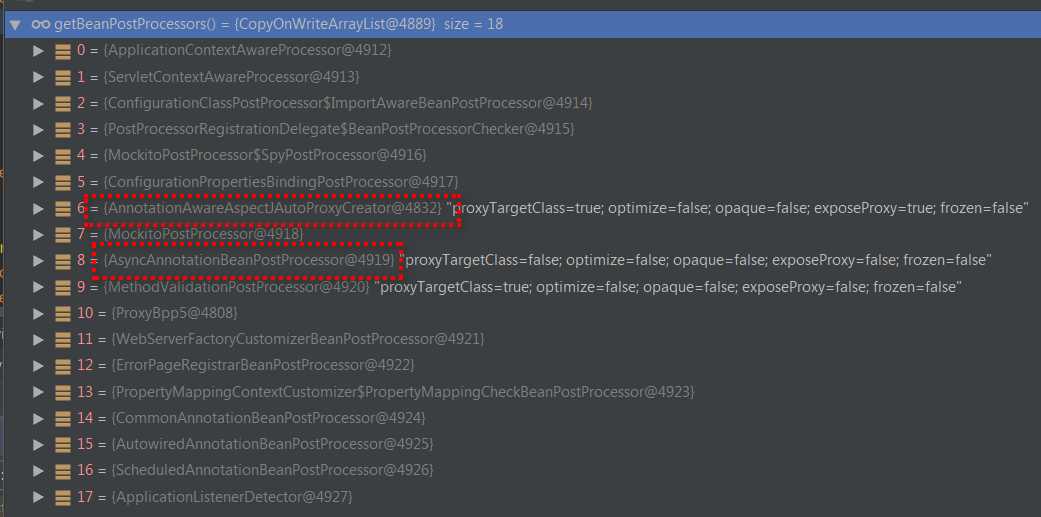
上图中AnnotationAwareAspectJAutoProxyCreator是AbstractAdvisorAutoProxyCreator的实例。也就是说AbstractAdvisorAutoProxyCreator类型的后置处理器优先于AsyncAnnotationBeanPostProcessor类型的后置处理器执行。AbstractAdvisorAutoProxyCreator BPP通过BeanFactoryAdvisorRetrievalHelper从当前的BeanFactory中拿到所有的advisor。
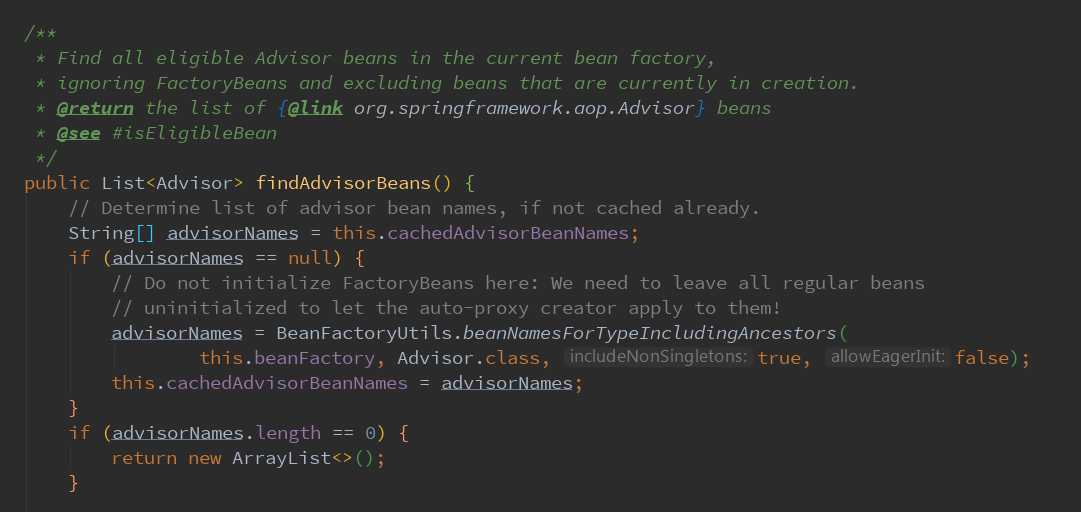
然后针对当前的bean(beanName = asyncWrapped )筛选出合适的advisor集合(包含RetryConfiguration实例)。最后是通过ProxyFactory创建的代理类,具体如下。
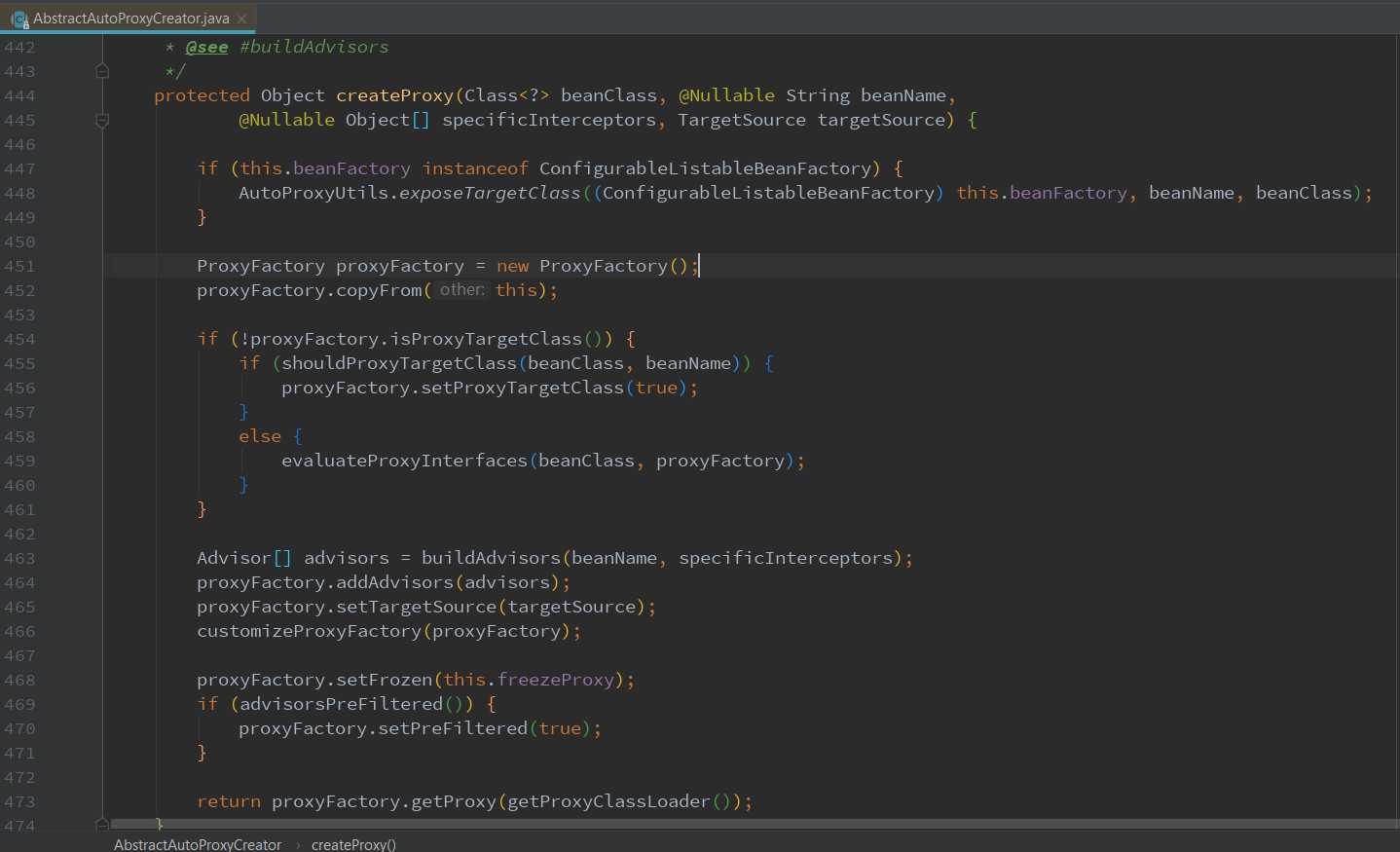
ProxyFactory通过默认AopProxyFactory即DefaultAopProxyFactory来创建Aop Proxy。
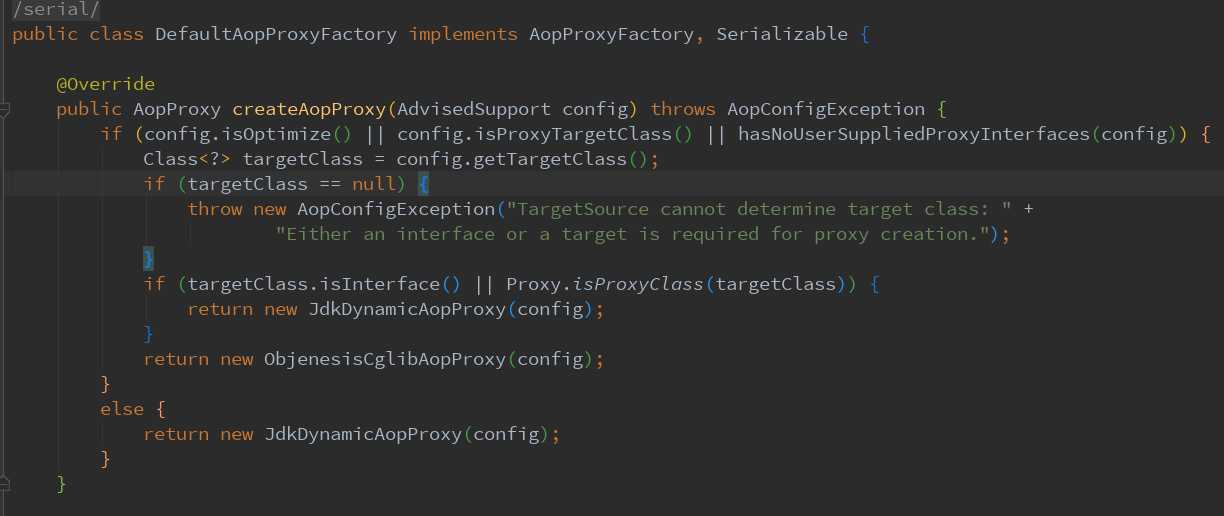
到这里,beanName = asyncWrapped 关于Retryable的代理对象已经创建完毕,并返回代理对象替代当前的bean。然后继续到AsyncAnnotationBeanPostProcessor#postProcessAfterInitialization()方法,处理关于带有@Async注解的bean。
//如果是advised
if (bean instanceof Advised) { Advised advised = (Advised) bean; if (!advised.isFrozen() && isEligible(AopUtils.getTargetClass(bean))) { // Add our local Advisor to the existing proxy‘s Advisor chain... if (this.beforeExistingAdvisors) { advised.addAdvisor(0, this.advisor); } else { advised.addAdvisor(this.advisor); } return bean; } } //这里的逻辑不会执行了 if (isEligible(bean, beanName)) { ProxyFactory proxyFactory = prepareProxyFactory(bean, beanName); if (!proxyFactory.isProxyTargetClass()) { evaluateProxyInterfaces(bean.getClass(), proxyFactory); } proxyFactory.addAdvisor(this.advisor); customizeProxyFactory(proxyFactory); return proxyFactory.getProxy(getProxyClassLoader()); }
以前总以为多个注解,就会多次创建代理,一层一层嵌套。现在明白了,是通过拦截器链来完成的。此时beanName = asyncWrapped对应的bean已经是Advised类型的实例了,然后将AsyncAnnotationAdvisor实例添加到Advised实例的advisors集合中。
为啥beanName = asyncWrapped对应的bean是Advised类型的实例?那还要从对beanName = asyncWrapped的bean创建代理类说起。那么接着回到通过DefaultAopProxyFactory来创建Aop Proxy。这里看一下CglibAopProxy,JdkDynamicAopProxy请自行查看。以下代码来自CglibAopProxy#getProxy()方法。
......
//设置需要代理的接口 enhancer.setInterfaces(AopProxyUtils.completeProxiedInterfaces(this.advised)); ......
//获取callbacks Callback[] callbacks = getCallbacks(rootClass);
......
//设置callback filter
enhancer.setCallbackFilter(new ProxyCallbackFilter( this.advised.getConfigurationOnlyCopy(), this.fixedInterceptorMap, this.fixedInterceptorOffset)); .....
设置需要代理的接口,除了目标类包含的接口,还需要添加一些额外的接口。如下是AopProxyUtils#completeProxiedInterfaces()方法中的内容。
...... if (addSpringProxy) { proxiedInterfaces[index] = SpringProxy.class; index++; } if (addAdvised) { proxiedInterfaces[index] = Advised.class; index++; } if (addDecoratingProxy) { proxiedInterfaces[index] = DecoratingProxy.class; } ......
看到了Advised.class哈,这就是为啥最终的代理对象是Advised类型的实例了。
获取callbacks集合,注意this.advisedDispatcher在数组中的索引是4,下面会用到。
Callback[] mainCallbacks = new Callback[] { aopInterceptor, // for normal advice targetInterceptor, // invoke target without considering advice, if optimized new SerializableNoOp(), // no override for methods mapped to this targetDispatcher, this.advisedDispatcher, new EqualsInterceptor(this.advised), new HashCodeInterceptor(this.advised) };
设置callback filters,如下是ProxyCallbackFilter#accept(Method method)部分源码。
...... if (!this.advised.isOpaque() && method.getDeclaringClass().isInterface() && method.getDeclaringClass().isAssignableFrom(Advised.class)) { if (logger.isTraceEnabled()) { logger.trace("Method is declared on Advised interface: " + method); } return DISPATCH_ADVISED; } ......
ProxyCallbackFilter的作用主要是根据不同类型的method,返回callbacks数组的索引。上面的DISPATCH_ADVISED变量的值是4。
这个AdvisedDispatcher是干什么的呢?
//Dispatcher for any methods declared on the Advised class.
private static class AdvisedDispatcher implements Dispatcher, Serializable { private final AdvisedSupport advised; public AdvisedDispatcher(AdvisedSupport advised) { this.advised = advised; } @Override public Object loadObject() throws Exception { return this.advised; } }
也就是如果method是Advised.class声明的,则使用AdvisedDispatcher进行分发。
AsyncAnnotationBeanPostProcessor#postProcessAfterInitialization() //如果是advised if (bean instanceof Advised) { Advised advised = (Advised) bean; if (!advised.isFrozen() && isEligible(AopUtils.getTargetClass(bean))) { // Add our local Advisor to the existing proxy‘s Advisor chain... if (this.beforeExistingAdvisors) { advised.addAdvisor(0, this.advisor); } else { advised.addAdvisor(this.advisor); } return bean; } }
上面的advised.addAdvisor(0, this.advisor); 相当于如下代码。
//spring aop cglib代理对象
public class XXXX$$EnhancerBySpringCGLIB$$8f47b115 implements Advised { private org.springframework.cglib.proxy.Dispatcher advisedDispatcher;//AdvisedDispatcher实例 ...... @Override public void addAdvisor(int pos, Advisor advisor) throws AopConfigException() { advisedDispatcher.loadObject().addAdvisor(pos, advisor); } ...... }
还需要补充的一个地方就是callbacks数组中有个aopInterceptor,对应的类型是DynamicAdvisedInterceptor(General purpose AOP callback. Used when the target is dynamic or when the proxy is not frozen.)。
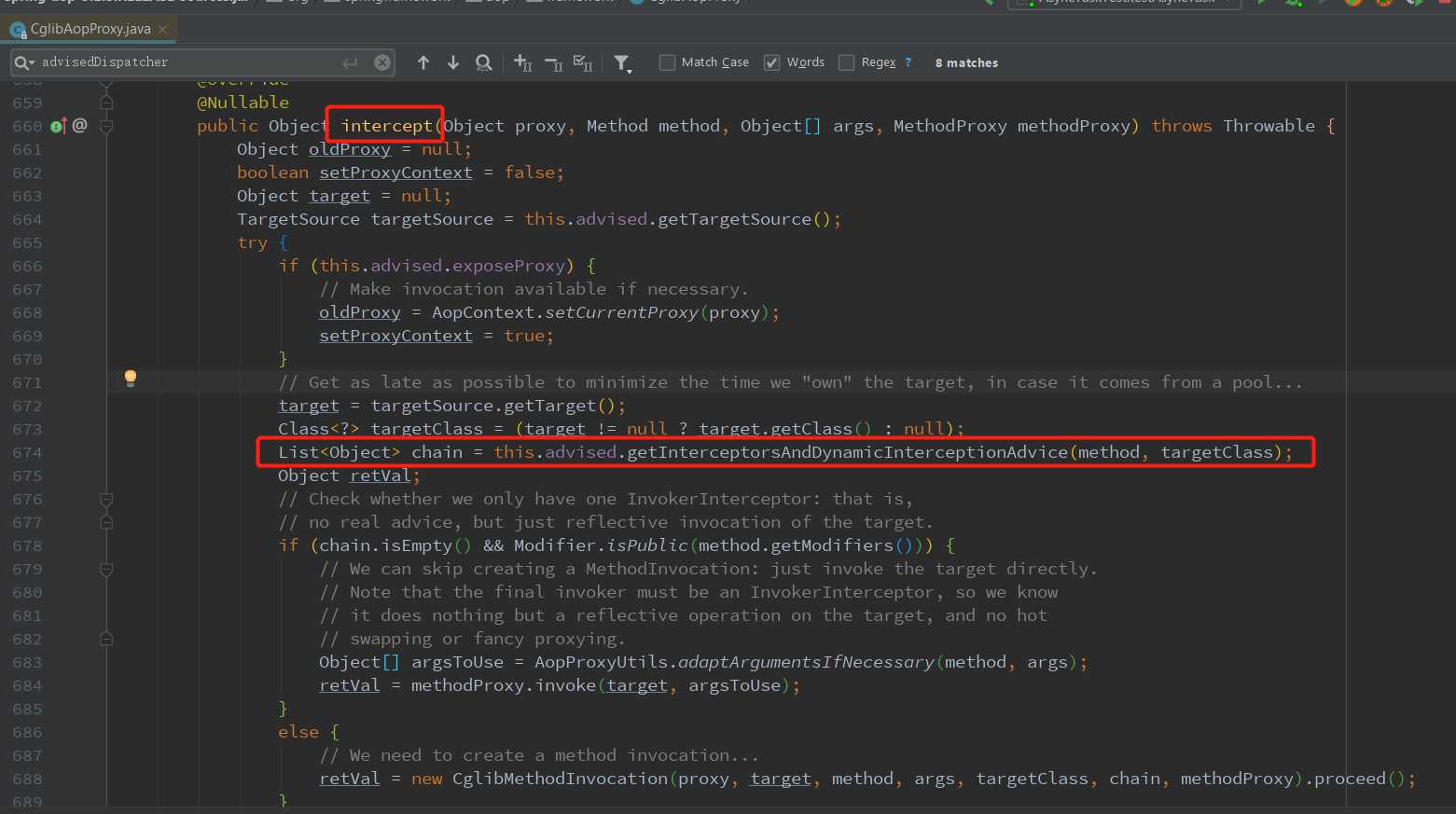
如上图所示,intercept方法中会通过advised(AdvisedSupport type, The configuration used to configure this proxy.)实例获取一个拦截器链,如果不为空,则返回一个CglibMethodInvocation实例。
至此,Spring异步调用原理及SpringAop拦截器链都已经分析完毕,希望对大家使用spring异步调用有所帮助。另外我自己也重新温习了spring aop相关的知识,也希望大家对spring aop有一个新的认识。如果有需要源码的同学,请f访问我的github。Spring异步调用原理及实现方案demo。
标签:custom root 实现 throw 对象 疑问 拦截器 collect 索引
原文地址:https://www.cnblogs.com/hujunzheng/p/10549849.html